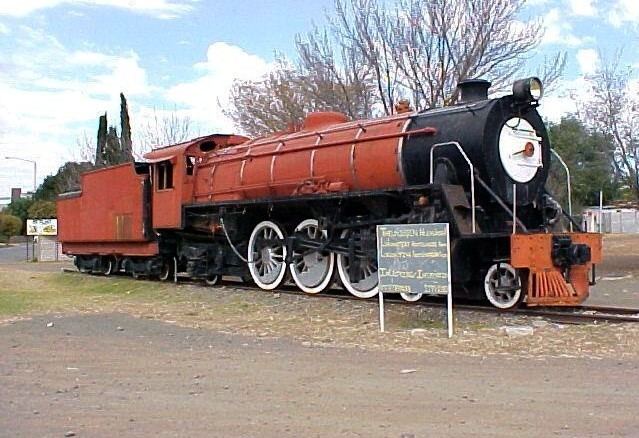Power type Steam Build date 1928-1929 | ||
 | ||
Designer South African Railways(Col F.R. Collins DSO) Builder Hohenzollern Locomotive WorksBaldwin Locomotive Works Serial number Hohenzollern 4653-4658Baldwin 60820-60827 | ||
The South African Railways Class 16DA 4-6-2 of 1928 was a steam locomotive.
Contents
In 1928, the South African Railways placed six Class 16DA steam locomotives with a 4-6-2 Pacific type wheel arrangement in passenger train service. Eight more entered service in 1929.
Manufacturers
Further orders for locomotives similar to the Class 16D Pacific type locomotive were placed for the South African Railways (SAR) in 1928. The design of the earlier engines was modified by the Chief Mechanical Engineer (CME), Colonel F.R. Collins, along the same lines as his design of the Class 15CA Mountain type.
This consisted of a locomotive bar frame which was shorter to end at the front of the firebox, with a bridle casting to create a widened frame extension below the firebox and the cab to the rear dragbox, to gain more ashpan room under the firebox.
These redesigned locomotives were designated Class 16DA and were built by two manufacturers in 1928 and 1929. The first six, numbered in the range from 868 to 873, were built in Germany by Hohenzollern Locomotive Works and entered service in 1928. Another eight locomotives, numbered in the range from 843 to 850, were built in the United States of America by Baldwin Locomotive Works and entered service in 1929.
Characteristics
The Hohenzollern and Baldwin-built Class 16DA locomotives basically differed from the predecessor Class 16D only by virtue of its shortened frame and bridle casting, the Class 16D having had a frame extending all the way from the front buffer beam to the rear dragbox. They used the same Type KT tenders with a coal capacity of 14 long tons (14.2 tonnes) and a water capacity of 6,000 imperial gallons (27,300 litres). As delivered, they had 60 inches (1,524 millimetres) diameter coupled wheels and their cylinders were of 22 inches (559 millimetres) bore and 26 inches (660 millimetres) stroke. Their boiler operating pressure was set at 195 pounds per square inch (1,344 kilopascals).
Modification
During the 1940s, six of these locomotives, three from each manufacturer group, were retyred with 63 inches (1,600 millimetres) diameter tyres on their coupled wheels. To not have their tractive effort reduced by the larger coupled wheels, their cylinders were reamed from a 22 to 23 inches (559 to 584 millimetres) bore and their operating boiler pressure was raised to 205 pounds per square inch (1,410 kilopascals). All the modified locomotives remained classified as Class 16DA.
When the larger tyres were fitted, the old tyres were left in position and turned down on the wheel centres to serve as liners, and the new tyres were then shrunk on over the liners. The practice of increasing the diameter of coupled wheels, wheel spacing and other considerations permitting, was begun by A.G. Watson during his term in office as CME and was continued by his successors. The reduction of tractive effort caused by the larger wheels, was made up by increasing boiler pressures or by fitting larger cylinders or both, as required. This policy resulted in more mileage between heavy repairs, less cost-per-mile on repairs and locomotives capable of higher speeds.
Service
The Class 16DA Pacifics were initially placed in passenger service between Johannesburg and Kimberley, where they regularly worked trains like the Union Express, which became the Blue Train after the Second World War, and the Union Limited.
In 1939-1940, when new air-conditioned rolling stock was placed in service on the Union Limited and Union Express services between Cape Town and Johannesburg, all the Class 16DA and Class 16E locomotives were transferred to Bloemfontein in the Free State. From here, they continued to work passenger trains north and south, including the Orange Express, until the Class 15F replaced them and they were relegated to suburban and local passenger train work. They were withdrawn from service in 1973.
Four of the Baldwin-built locomotives were sold into industrial service. No. 844 went to Hlobane Colliery in Natal and later to Umgala Colliery. Numbers 845, 847 and 848 went to Wankie Colliery in Rhodesia, where they became numbers 5 to 7 in reverse order. After they were finally withdrawn in 1982, one of these three was plinthed alongside the main North road at Hwange. Another of the Baldwin-built locomotives, no. 850, is plinthed at Theunissen in the Free State.
Works numbers
The table lists the Class 16DA engine numbers, builders, years built, works numbers and variations in coupled wheel sizes.
